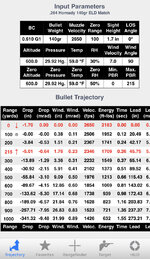sometimes, or more often than not, we figure out the simplest/best way right out of the gate, and as per human nature, we go fack it up and then have to come up with a whole new set of solutions to deal with the can of worms we just opened up...it's what we do best, I think they call it occams razor

wind is almost entirely subjective game, as you agreed with the math you do as well, it's up to us to figure out the wind value, our gear can only tell us roughly what's going on, you transpose your subjective wind math to your multi-aimpoint style reticle and depending on what plain it's on you may have to ensure you're on the right scope magnification so there's a step many won't wanna forget, I don't add any unnecessary steps and if you don't have to remember to dial magnification up then you are pretty much the same...you just have to move your chosen hash mark or gap between chosen hash marks and hover that over kill zone, you saying you don't gap hash marks? that's a bit Kentucky no? I just have to move up to about 18" worst case and touch off, in the real world I'll land within 2" of you all day long and I'll be in the kill zone and I'll be there just as fast or faster
your system will make your 300 yard gophers fun, I run mil-dots on my .22's for gophers, we just spot hits from 50-100 and then see what dot is needed and clean up that area and move to the next batch of rats, keep it pretty simple that way, all your wind holds are off target though...not so with big game
from 6.5 Grendel, to 6.5 Creedmoor, to 6.5 PRC, .5 to .625 bc, a typical .8 second time of flight gets you to 550, 600 and 650 yards respectively from 20" barrels, dialling up 6' to 6.4' of elevation on all 3 respectively at those .8 second distances, your full value 10 mph crosswind 19.4" to 22.4" for each of them at those same ranges, a pretty good rule of thumb distance potential for most of us above average players pushing our gear closer to potentials and min impact velocity distance thresholds, so...all we're typically dealing with is sub 2' foot of windage worst case and game that is much larger than that...that is not the same as gophers, it's not the same as prs if talking 8" or 10" gongs, we have full animals to reference against in big game hunting...that's very usable! why is that not discussed more? too many guys looking at little gongs I guess and fall down the rabbit hole
it's not that complicated, many make this out to be much more complicated than it is, big game kill zones have a little wiggle room that's not hard to land inside, most of our wind holds are under 18", what do you need for that again? Mil's? please...I don't add any angular anything outside dialling up to about 5' of elevation as I call'r quits around 500 with my short barrel Grendel although I know every click beyond 500 up to 600 is 5 more yards I can certainly still scare the crap out of and hit some yappies after 500 if they wanna sit down and stick their tongues out, don't bet against me getting it right, seeing a foot out there with animal we know so well is as precise as you're multi aim point reticle, whoever reads the wind call and does his quick math best will be closer to the 10 ring...it's not gonna be measurable between the reticle hold or the inches hold between guys who know their set up and game
gophers yes, they're only 2" wide lol, so you're off body hold on everything past mbpr, if you gotta hold 3' of wind on them then you're gonna want aim points on the reticle or dial in...that would be akin to holding 8'-10' for a deer...but we don't hold way off target on big game do we? no...we are almost always on fur depending they way they're pointed to the cross wind, not hard to move a few inches out front if you know you need 18" total, you're gonna get those balloons
if op stated mils are best for gophers and prs or big game over 700 yards I wouldn't have said a thing lol but his blanket statement being in the backpack hunting section where most assume big game primary...well...I just had to start spittin, I'm sure they work great but I disagree they are the best



